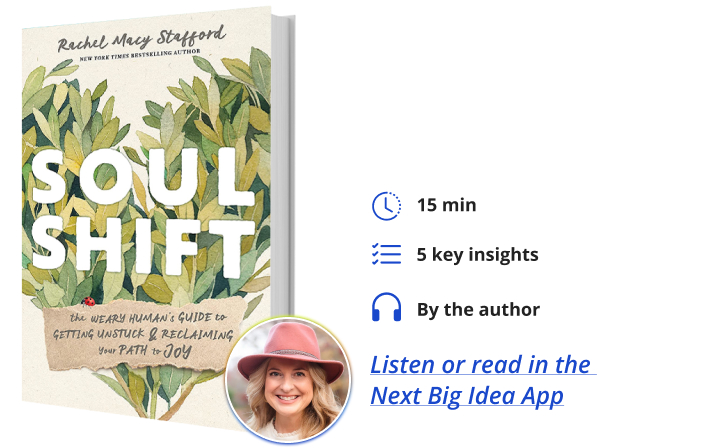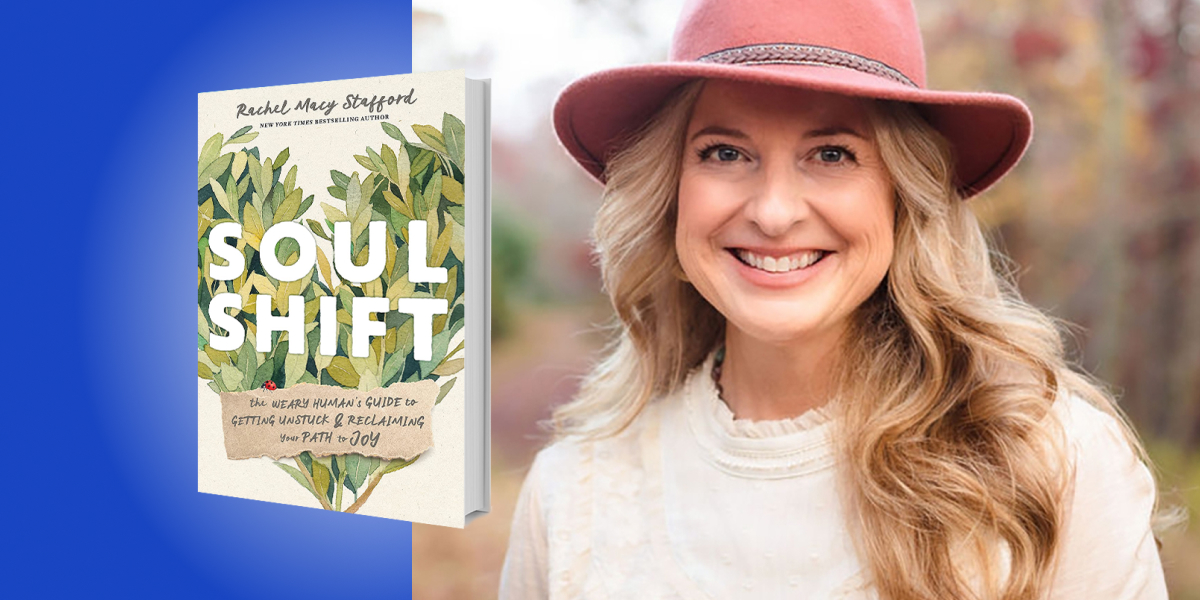Rachel Macy Stafford is a certified special education teacher, public speaker, and New York Times bestselling author of Hands Free Mama, Hands Free Life, Only Love Today, and Live Love Now.
Below, Rachel shares 5 key insights from her new book, Soul Shift: The Weary Human’s Guide to Getting Unstuck and Reclaiming Your Path to Joy. Listen to the audio version—read by Rachel herself—in the Next Big Idea App.

1. Shifts begin when we acknowledge painful truths.
I’ll never forget the words my husband Scott said to me years ago, just as we were finally pulling out of the driveway to go on a family vacation, “You’re never happy anymore.” I wanted to scoff and tell him he was wrong, but his words affirmed a feeling that kept bubbling up inside me, one that I’d been trying to ignore.
I took Scott’s words as a cue that it was time to admit a painful truth to myself: I was becoming someone I didn’t want to be. A person who was missing her life by standing on the outskirts of every experience as a critical observer rather than a joyful participant. Admitting the truth about how unfulfilled I felt was critical. Acknowledging the truth allowed it to lead and enlighten me. This process is the essence of Soul Shift, a life-changing journey of paying attention to cues that help us uncover and respond to our deepest truths in ways that inspire positive change and lasting transformation.
2. Shifts happen through small, incremental steps.
Acknowledging the painful truth was necessary before I could commit to making a change. Still, I needed a realistic plan of action for making that change stick. Like most adults, I had obligations and responsibilities. I knew I couldn’t drop everything in order to cultivate joy, so I reached for something I’d learned while teaching students with behavior issues. Real transformation doesn’t happen with big sweeping changes. It happens through small, incremental steps bolstered by awareness and compassion. My first step towards joy involved practicing a daily distraction-free period where I’d check in with myself. Instead of using the first few minutes of my day to check my phone, I implemented a practice of presence. For 10 minutes, I would set aside all the distractions to connect with myself. Sometimes I would journal. Other times I would read letters from my grandma, who always saw the good in me.
“What I did during these distraction-free windows didn’t matter as much as the conditions.”
Little did I know, this practice of presence would be the foundation for a return to my authentic self and to true joy. I say return to joy because the answers for living more joyfully are inside us, but we must give ourselves time and space to get in touch with our body, our limits, our needs, and our core values. What I did during these distraction-free windows didn’t matter as much as the conditions. Whether I was alone or with someone, whether I was writing or simply breathing, there was no phone, no computer, no agenda, no to-do list, and no expectations. I just showed up with a posture of acceptance, willing to listen to the feelings or thoughts that surfaced in the stillness.
I soon discovered that my commitment to touch base with my inner world before touching base with the outer world was enlightening and empowering. Listening to the world’s opinions and expectations was what had often led me astray from my authentic path. Starting my day with what fulfilled me, instead of depleted me, created momentum that lasted well beyond those initial 10 minutes. Making small shifts creates powerful ripple effects.
3. Shifts occur when we deem ourselves worthy.
As I practiced presence, I became aware that getting in touch with my needs and uncovering my joys was often challenging. I told myself I had to earn rest, play, delight, and peace. In American culture especially, we are conditioned to compete, produce, serve, perform, and accommodate to prove our worth. We don’t naturally deem ourselves worthy of the time, energy, care, and love required to invest in ourselves. These internalized beliefs become roadblocks to experiencing authentic joy because we are constantly trying to meet expectations outside our control. That keeps us distracted and detached from the core of who we are and what we need to thrive.
Unfortunately, I had to learn this the hard way through a health scare in 2015. I was pushing myself way beyond reasonable limits and ignoring an ongoing physical pain, because I told myself I didn’t have time to address it. In a moment of frustration, I raised a casserole dish over my head and smashed it on the kitchen counter, terrifying my then 12-year-old daughter. When I went to Natalie’s room to apologize, I admitted a painful truth I hadn’t admitted to myself. “I’m not handling my stress very well right now,” I told her, “and I think it’s because I’m not taking good care of myself.” Much to my surprise, Natalie presented me with a slew of life changing facts about sleep, hydration, and nourishment.
“Taking small steps to show up even when I felt inadequate or unprepared forged a path to much deeper change.”
Seeing her concern for my well-being led me to seek medical attention, which resulted in surgery for a giant kidney stone and a powerful wake-up call. Failing to deem myself worthy of prioritization was negatively impacting my life and those I loved. I took this wake-up as an invitation to invest in myself regularly.
One way was through Hat Days. Remembering the eight-year-old me who had a fondness for wearing hats and exploring nature, I began to bypass the mirror every Saturday morning, which was where my voice of self-judgment was loudest. Placing the hat on my head renewed my mindset of spontaneity, courage, and lightheartedness. In my hat, I was eight-year-old Rachel, the girl who seized every opportunity to laugh, run, play, live, and love. Taking small steps to show up even when I felt inadequate or unprepared forged a path to much deeper change.
4. Shifts happen when we release roles that no longer serve us.
Looking back, I realize the significance of the hat. Not only did it serve as a tangible anchor to the core of who I am, but it also served as a boundary-setting tool. Hat Days meant no mirror, no work, and no responding to messages. Placing boundaries around what I would and would not do on Saturdays protected my time, focus, and energy for relational and emotional investments that matter to me. As someone who derived her worth from pleasing and accommodating others, setting this boundary did not come easy. Through education and introspection, I’ve come to understand why.
Boundaries are an expression of self-worth. They communicate who we are, what we think, how we feel, and what we will and will not tolerate. The protective boundaries I was learning to set on Saturdays began carrying over to other personal times and places. What I found more challenging was setting boundaries in my professional life. I confided in my friend Shannon that writing, something that always brought me joy, had become so depleting that I might quit. I explained that the more public my writing became, the more expectations were put on me. Shannon said, “Rachel, you’re a map maker, not a baggage carrier, not a tour guide and not a travel agent. You are there to guide and accompany people through their own journey, not to carry stuff that doesn’t belong to you.”
“Boundaries are an expression of self-worth.”
With Shannon’s analogy, it became clear I was spending too much energy fulfilling aspects of my job that were either assigned to me or assumed of me, or purposeful at one point, but only hindering me now. Continuing to fulfill these roles was counterproductive to my goals, and harmful to my well-being. The act of classifying my roles helped me make better choices with my time, focus, and energy. In Soul Shift, readers are given tools to identify their fillers and depleters. Releasing roles that no longer serve a person unleashes opportunities to invest time, focus, and energy in fulfilling roles.
5. Shifts create space for our gifts to flourish.
With boundaries in place, I finally had the time and energy to do something I’d wanted to do since I was a child: volunteer at a local cat shelter. Every Sunday afternoon, my daughters and I would go visit the cats that were housed at a local PetSmart. In photos Natalie took of me holding the cats for the shelter website, I saw something in myself I hadn’t seen in a long time: peace, contentment, joy. It reminded me of my eight-year-old self, the mixtape maker, animal lover, and notebook filler with dreams of becoming an author. No longer did I see someone who was missing her life. I saw a joyful participant.
When you go where your heart calls, you are fulfilled. I don’t believe you find your purpose. I believe your purpose finds you when you go toward what delights your heart. Decide that you won’t live over-scheduled and undervalued. Establish healthy boundaries and self-care habits. Discover what makes you feel truly alive.
To listen to the audio version read by author Rachel Macy Stafford, download the Next Big Idea App today:






























